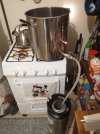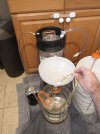I've been doing no-chill into a cleaned, sanitized, purged corny keg since May 2022. I run hot wort into the open lid after boil (if I'm doing something hoppy, after hopstand), close it up, purge and pressurize it, then sit it in the corner of my kitchen until it's cooled to ambient temps the next day. Then I use CO2 to push it from the corny into a prepared carboy (yes, I still use glass carboys; I have 2 1-gal and 2 3-gal and have never broken one in >10 yrs brewing with them). The initial cooled wort out and the final bit of wort I discard has some of the cold break in it, so I get the cleanest, clearest wort into my fermenter. Have had no problems and have placed/ribboned in many competitions with my beer chilled this way.










